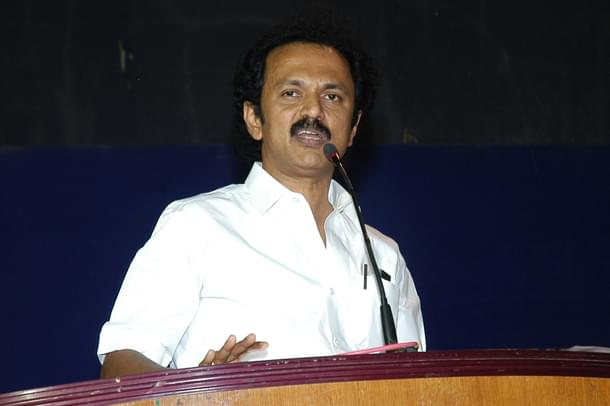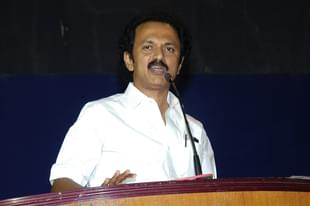Politics
Choosing His Own Crisis: Is Stalin Committing To A Deal That Will Limit Him?
D V Sridharan
May 01, 2017, 09:36 PM | Updated 09:36 PM IST
Save & read from anywhere!
Bookmark stories for easy access on any device or the Swarajya app.


Politics in Tamil Nadu since Jayalalitha’s demise must confound people outside the state. The stream of headlines from the state is unending. The split in All Indian Anna Dravida Munnetra Kazhagam (AIADMK), jailing of Sasikala, barefaced bribery in the R K Nagar by-poll and its postponement, the arrest of Dinakaran, and the farmers’ protest staged in Delhi stand apart from the jallikkattu protests and the worst drought in the state in 140 years. The Jallikattu protests enjoyed popular support, and everyone is despondent about the drought. It is the news other than these two, however, that would tell us a political story
Have the stories of chaos and instability made Tamils long for a new party, say the Bharatiya Janata Party (BJP) led by its ever-conquering leader Narendra Modi?
The answer is a big no.
This must surprise the north and the east of India, where Modi is a beloved name. Even in Bengal, once an unthinkable territory for BJP, there are sprouts of hope for the party, forcing Mamata Banerjee to attempt some feeble balancing acts. BJP meetings there attract good crowds. In Tamil Nadu though, BJP is no force at all.
I am privy to views of some well-wishers of the BJP on what ails it in this state. They point out that BJP leaders tend to be dismissive of Tamil sensibilities and seem unable to convey what true Hindu Dharma is, namely inclusiveness. This inability, though, has given room to its critics in the state to brand the party as a Hindi-imposing ‘Aryan’ ruse bent on wiping out Tamil and Dravidian identities.
Whatever be the reason, the BJP for some time to come will not be a major player.
But if we leave that alone for a moment, what is it with today’s Tamil Nadu, that makes it worth our time to study it?
Let’s start here: Since Annadurai commenced the uninterrupted rule of Dravidian parties in the 1960s, every chief minister in the state has been a charismatic personality. Of these, Jayalalitha stood out both for her charisma and hauteur. While other chief ministers often sought deals with national parties, she was disdainful even when she needed an alliance.
She was reported to be on friendly terms with Prime Minister Narendra Modi. In 2014 he was swaying the country with his campaign. He drew massive crowds in Trichy and other Tamil cities - even when speaking in Hindi, too. Everyone assumed an alliance with AIADMK was a given.
The Iron Lady ignored him.
She was a massive presence. Her disappearance from the scene has created an unstable polity.
Historically, both the Dravidian parties have allied with a national party at one time or the other. Vajpayee was not an untouchable to the Dravida Munnetra Kazhagam (DMK) which had railed against the Babri Masjid demolition, nor was an alliance with DMK unacceptable to Sonia Gandhi, whose party had earlier brought down Gujral’s government for not throwing out the DMK - the alleged conspirators in her husband’s assassination.
All chief ministers who ruled Tamil Nadu, except Jayalalitha, have actively sought cordiality with the ruling party in Delhi, either to avoid administrative friction or for agglomerating vote share at the state level.
BJP’s vote share in the 2014 elections in Tamil Nadu was only five per cent, but that was third after the AIADMK and DMK. The BJP-led front came second in 5 constituencies and won two seats. If it holds on or increases that share, it cannot be ignored.
The AIADMK has been exorcised of doctrinaire Dravidianism by Jayalalithaa and Karunanidhi is a wily old fox who can spin his way into alliances and out.
But it is Stalin who prompts the question: is he taking his party to a deal that will limit its options?
The deal I refer to is the one being put together by shrewd masterminds namely, NGOs and the Church. Both foresee Modi becoming a key player in Tamil Nadu, which Stalin alas, does not seem to. They see in Modi’s dominance in national politics a threat to them, while DMK does not see the inevitability of having to cut a deal with him someday.
The narrative being generated is one of Tamil identity being in danger. An easy way to identify the ‘traitors’ is this. Anyone who supports or allies with BJP is an anti-Tamil. The arch enemy is, of course, Narendra Modi. A recent article in Swarajya by Suhas brilliantly lays the plot bare.
The strategy is to join every event or issue that evokes public sympathy and steer it to a point where Modi can be shown as the villain. It happened during the closing stages of the pro-Jallikattu agitation on the Marina. And, it showed in the Tamil ‘farmers’ burlesque staged in Delhi. Karnataka’s ‘obduracy’ in the Cauvery water dispute too is a Modi plot, according to this theory. Islamists who loathe Modi, die-hard Tamil separatists, Dalit identity politicians, communists rendered irrelevant, Kudankulam protesters who were finessed by Jayalalithaa can all be identified in the assembly, but not quite so easily, the masterminds.
But why should they be alarmed? They know that if BJP grows to even say 8 per cent vote share in Tamil Nadu, they will face an existential crisis. As it is, the Foreign Contribution (Regulation) Act FCRA rigours and stricter visa filters applied on evangelists have affected them considerably. Church-backed groups also manifest as NGOs working for Dalit causes, as environmentalist groups, human rights activists and so on.
The objective is not mere conversion but to capture the state’s bureaucracy, education, police. The FCRA monitoring that began in 2014 has alarmed them and put them on overdrive.
M K Stalin, by aligning with their interests and by endorsing their narrative is, in fact, limiting the political choices that will be available to him in the future. He betrays a needless panic that exposes an insecure personality. He’s making it hard for himself to win as a politician.
(Image: Kumarrajendram/Wikimedia Commons)
D V Sridharan was a sea-going engineer in the 1960s. For the last 40 years, he has been passionate about the environment, especially water conservation and eco-diversity. He’s currently in the second decade of his land regeneration work at pointReturn, 100km south of Chennai. He tweets at @strawsinthewind.





